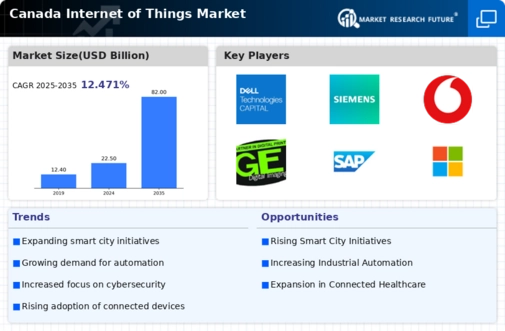Government Initiatives and Support
Government policies and initiatives play a crucial role in shaping the internet of-things market in Canada. The Canadian government has been actively promoting digital innovation through funding programs and strategic partnerships aimed at fostering IoT development. For example, initiatives such as the Innovation Superclusters Initiative aim to accelerate the growth of technology sectors, including IoT. This support is likely to enhance research and development efforts, leading to the creation of new applications and services. Furthermore, the government's focus on smart city projects is expected to drive the adoption of IoT solutions in urban planning and infrastructure management. As public sector investment increases, the internet of-things market is poised for substantial growth, benefiting both businesses and consumers.
Rising Demand for Smart Home Devices
The increasing consumer interest in smart home technologies is a notable driver for the internet of-things market. In Canada, households are progressively adopting devices such as smart thermostats, security cameras, and lighting systems. This trend is reflected in a market growth rate of approximately 25% annually, indicating a robust demand for interconnected devices. The convenience and energy efficiency offered by these technologies appeal to a wide demographic, from tech-savvy millennials to older generations seeking ease of use. As more Canadians embrace smart home solutions, the internet of-things market is likely to expand, fostering innovation and competition among manufacturers. This shift not only enhances consumer lifestyles but also contributes to energy conservation efforts, aligning with national sustainability goals.
Integration of AI and Machine Learning
The convergence of artificial intelligence (AI) and machine learning with the internet of-things market is transforming how data is utilized in Canada. By integrating AI algorithms into IoT devices, companies can analyze vast amounts of data in real-time, leading to more informed decision-making. This integration enhances predictive analytics capabilities, allowing businesses to anticipate trends and respond proactively. For instance, in sectors like agriculture, AI-driven IoT solutions can optimize crop yields by analyzing soil conditions and weather patterns. The potential for improved efficiency and productivity is driving investment in these technologies, with projections indicating a growth rate of 20% in AI-enabled IoT applications. This synergy not only enhances operational capabilities but also positions Canada as a competitive player in the global technology landscape.
Expansion of Industrial IoT Applications
The industrial sector in Canada is increasingly leveraging the internet of-things market to enhance operational efficiency and productivity. Industries such as manufacturing, logistics, and energy are adopting IoT solutions to monitor equipment, optimize supply chains, and reduce downtime. For instance, predictive maintenance powered by IoT sensors can lead to a reduction in maintenance costs by up to 30%. This trend is indicative of a broader shift towards automation and data-driven decision-making in Canadian industries. As companies recognize the potential for cost savings and improved performance, investment in IoT technologies is expected to rise significantly. This industrial transformation not only boosts the economy but also positions Canada as a leader in the adoption of advanced manufacturing technologies.
Growing Focus on Sustainability and Energy Efficiency
The increasing emphasis on sustainability and energy efficiency is a significant driver for the internet of-things market in Canada. As environmental concerns rise, consumers and businesses alike are seeking solutions that minimize their carbon footprint. IoT technologies facilitate this transition by enabling smarter energy management systems, such as smart grids and energy-efficient appliances. Reports suggest that implementing IoT solutions can lead to energy savings of up to 15% in residential and commercial buildings. This growing focus on sustainability aligns with Canada's commitment to reducing greenhouse gas emissions and promoting renewable energy sources. As more stakeholders prioritize eco-friendly practices, the internet of-things market is likely to experience accelerated growth, fostering innovation in sustainable technologies.
























Leave a Comment